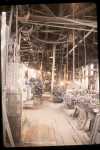EBT Virtual Tour
Machine Shop


HAER Map Key:
1
Date Built: unknown
Also see the Machine Shop in the EBT Virtual Tour.
The Machine Shop is is where machining on metals takes place. Machinng is the process of shaping metal by means of sharp cutting tools. Maching is used where precise tolernences are needed because the process can be tightly controlled, unlike casting or forging. Machining conisist of four main types of operations.
Drilling - Drill Press
Drilling is the machining operation of cutting away material from a fixed workpiece by a rotating a cutting tool. The speed of the cutting action is provided by the rotation of the cutting tool and the feed my moving the cutting tool along the axis of its rotation. The proecess occurs on a machine called a Drill Press. In a Drill Press the cutting tool in placed in a clamp called a Chuck with provides its rotation and axial movement. The workpiece is clamped on a table in line with the axis of rotation.
Drilling is used to place or enlarge round holes in the workpiece. The tool can only be moved along the axis of rotation (usually vertically) when machining is in progress and only round holes can be made in the workpiece.
The East Broad Top currently has four drill presses, three of which are in the Machine Shop and one in the Boiler Shop. One of the Machine Shop drills is a radial drill which enables the feed machanism to be moved around the perimiter of the machine.
Turning - Lathe
Turning is the maching process of cutting away material from the outside of rotating workpiece by a fixed cutting tool. The speed of the action is provided by the rotation of the workpiece and the feed by the movement of the tool PARALLEL TO the axis of rotation. The process occurs on a machine called a Lathe. In a Lathe, the tool is held by a sliding holder that moves along the side of the workpiece. The workpiece is held in place by a headstock and somtimes a tailstock which give it its rotation. Lathes most always have a horizontal axis of rotation.
Turning creates a cylindrical surface on the work piece. The diamater may vary along the length with adjustment of the tool holder.
The East Broad Top has an impessive six lathes in the Machine Shop. Three of those are specialty lathes configured for specific types of turning.
Boring - Boring Machine
Boring is the machining process of cutting away material from the inside of rotatating workpiece by a fixed cutting tool. The speed of the action is provided by the rotation of the workpiece and the feed by the movement of the tool ALONG to the axis of rotation The process occurs on a machine called a Boring Machine. In a Boring Machine the tool is held by a sliding holder that moves into the wokkpiece along the end of the axis of rotation. The workpices is clamped to a rotating table. Boring machines usualy have a vertical axis of rotation but can sometimbes be horizontal.
The East Broad Top has one vertical and one horizontal boring machine.
Lathe and Boring Machine
The Lathe cuts away material by rotating a workpiece against a fixed single-point cutting tool. Although the tool is fixed relative to the rotation of the piece, it can be moved along its legnth and moved toward and away from the workpiece's axis. Turning produces cylindrical parts.
There are several types of operations that can be performed by turning:
Lathe
Turning is the machining operation of cutting away material from a worklpiece rotating around a horizontal axis by a cutting tool that can be moved parallel and perpindicular to it axis of rotation. Lathes are the machines used for turning and are designed to make cylindrical pieces.
Turning
Turning involves moving a tool along the axis of rotation of the workpiece, adusting its distance from the workpiece's axis to change the diamater of parts of the work piece.
Facing
Facing invoves moving a tool perpindicular to the axis of rotation of the workpiece only, to create a flat face on the part. Facing is usually done on the end of a workpiece.
Parting
Parting involves moving a tool perpindicular to the axis of rotation of the workpiece only, to create a groove in the workpiece, or to sever part of it completely.
Drilling
Boring
Threading
Milling - planer
Milling is the process of cutting away material by feeding a workpiece past a rotating multiple tooth cutter. Milling can be vetical, with the cutting tool perpindicular to the surface being milled, or horizontal, with the cutting tool parallel to the surface being milled.
Planing
Boring - Chuck Lathe or Boring Machine
Boring involves enlarging and existing hole, made by a drill or casting. In the EBT shops, a common boring operation is pefromed on the centers of wheels. The rough hole in the center is bored out to a precisely machined hole that is fractionally larger than the machined axle end. They must be precise as friction holds the wheels onto the axles.
The EBT Machine Shop has one vertical and on horizontal Boring Machine.
Shaper
A shaper is
Sloting
Pressing
Technically, this is not a machining operation. Pressing is the process of forcing two parts together or apart. The pieces have very


